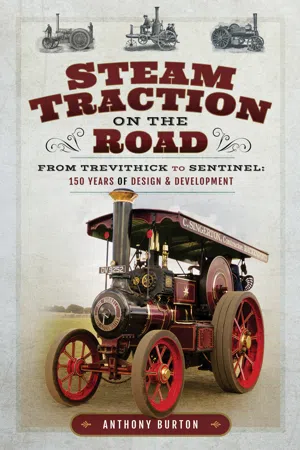Technology & Engineering
Nikolaus Otto
Nikolaus Otto was a German engineer who is best known for inventing the four-stroke internal combustion engine, also known as the Otto cycle engine. His innovation revolutionized the automotive industry and laid the foundation for modern transportation. Otto's engine design significantly improved fuel efficiency and power output, making it a pivotal development in the history of technology and engineering.
Written by Perlego with AI-assistance
Related key terms
3 Key excerpts on "Nikolaus Otto"
- eBook - ePub
Exceptional Creativity in Science and Technology
Individuals, Institutions, and Innovations
- Andrew Robinson(Author)
- 2013(Publication Date)
- Templeton Press(Publisher)
8 But the work of these laboratories was not as radical as Edison’s initial vision. To realize his system, Edison made use of modern science but had to possess an independent insight as an engineer to overcome scientific opposition to his ideas.INTERNAL COMBUSTION
The early automobile owed nothing to basic science. The nineteenth-century internal combustion engines of Etienne Lenoir and Nikolaus Otto and the early gasoline cars of Karl Benz, Gottlieb Daimler, and René Panhard and Emile Levassor in Europe were the work of engineers. The seminal figure Nikolaus Otto invented the modern four-stroke engine cycle but did so without a knowledge of the thermodynamics involved.9 The auto industry rose to a dominant position in the American economy as a result of Henry Ford’s 1908 vision of a revolutionary car, the Model T Ford, and his engineers then perfected a manufacturing system, the moving assembly line using standardized parts, that enabled him to mass-produce the Model T and reduce the price. Hundreds of thousands of Americans in town and country took to the road as a result, and by the mid-1920s, when consumers finally began to want more variety in cars, America had come to depend on motor vehicles.10Ford had little education, but his assembly line is often cited as an example of “scientific management,” a term popularized by Frederick Winslow Taylor in a 1911 book.11 Taylor advocated time and motion studies to make workers more productive, with the aim of making existing production systems more efficient. If Ford had followed Taylor, he would have tried to achieve marginal efficiencies in the earlier method of auto assembly, in which cars never moved until they were finished by workers who moved from car to car to perform particular tasks. Instead, Ford placed workers at different points on an assembly line and moved the cars to them. He timed his assembly-line workers in order to manufacture motor vehicles in a radically new way.12 - eBook - ePub
Steam Traction on the Road
From Trevithick to Sentinel: 150 Years of Design & Development
- Anthony Burton(Author)
- 2018(Publication Date)
- Pen & Sword Transport(Publisher)
The first real breakthrough was made in 1859 by the Frenchman Étienne Lenoir who designed an engine in which the explosive force was provided by a mixture of gas and air, ignited by an electric spark. It proved too expensive to run, costing a great deal more than the equivalent steam engine. The next stage of development was the work of another French engineer, Alphonse Beau de Rochas. He proposed a cycle of events based on a horizontal engine. It began when the piston was moving towards the crankshaft and the gas-air mixture was drawn into the cylinder. On the second stroke, the gas was compressed and at dead centre, the gas was ignited, driving the piston for the third stroke. On the final stroke, the burnt gases were exhausted from the cylinder. This is the four-stroke cycle – injection, compression, ignition, exhaust. He patented the idea, but never developed it and the patent lapsed. In 1878, the German engineer Nikolaus Otto developed the same idea – it is not clear whether or not he had heard of the Beau de Rochas - but the 4-stroke cycle became known as the Otto cycle. He was a practical engineer who realised that he could use coal gas as a fuel and that this was a commercially viable system. Within a few years over 30,000 Otto gas engines, manufactured by Otto & Langen, were at work all round the world. There were obvious advantages to the new engines, not least the fact that they could be worked from a town gas supply and no one had to be paid to keep a furnace stoked to provide the power. But that also meant that they were strictly limited to wherever the gas was supplied – they were not at this stage of any value to the world of transport. No one seriously considered the idea of taking a large reservoir of methane gas along to keep a vehicle moving. But once the idea of the internal combustion engine had been well and truly established and its advantages appreciated, it was only a matter of time before new ways of using it would be found. What was needed was an easily portable fuel source.Léon Serpollet’s - Alexander V. Dimitrov(Author)
- 2017(Publication Date)
- CRC Press(Publisher)
An improvement in thermal engines gathered momentum in the mid-19th century and consisted of efficiency increase and the minimization of engine overall dimensions. The innovative idea was to combine the combustion chamber and the power cylinder into one solid machine unit. This new concept materialized in the “internal combustion engine”. Otto and Langen were the first to practically realize the idea in 1858. Later, Atkinson (1882), Rudolf Diesel (1890), and Miller (1947) modified and improved it, while a modern version of the engine is that of Felix Wankel (1951).Another thermal technology adopting engine partition into functional volumes was designed by Lenoir (1859) and modified by G. Brayton (1872) and Humphrey (in the 1930s). The receiver, compressor, combustion chamber, fuel and flue systems, although mounted in one casing, were physically isolated in separate volumes. The thermal technology was widely applied in gas turbine and aviation turbo-jets, turbo-propeller motors and jets (serial manufacture did not begin until the middle of the 20th century).The whole 20th century was marked by the improvement of internal combustion engines. Better understaning of the thermal cycles and mechanical construction, and the usage of cheap and easily accessible fuel (oil at the end of the 19th century and natural gas at the end of the 20th century) resulted in the market domination of engines as devices that converted heat into mechanical work. We shall analyze in what follows the basic types of engine technologies that employ the direct thermodynamic cycle as an operational basis for most vehicles. We shall also outline the application of these technologies in industry and in the generation of electricity.
Index pages curate the most relevant extracts from our library of academic textbooks. They’ve been created using an in-house natural language model (NLM), each adding context and meaning to key research topics.


